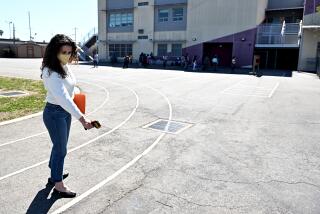Costs of district’s building plan soar
The projected shortfall in the new Los Angeles Unified School District’s campus construction program has ballooned from $1.6 billion to at least $2.4 billion in the last six months, the result of spiraling construction costs. And Los Angeles school officials, who were already scrambling to cover the lower shortfall, have no plan in place that would entirely make up the gap.
The alarm from staff members emerged Thursday during a committee meeting of the Los Angeles Board of Education. It was a familiar one -- but with much higher numbers. Last November the messenger had been outgoing Supt. Roy Romer, who warned of potential trouble to come in the $20-billion-plus school construction and modernization program -- the nation’s largest -- which has been a point of pride for the school district.
“We have the end in sight,” chief facilities executive Guy Mehula said in an interview. “But putting too many of these projects on hold will not only increase costs, it will delay further our goal of getting a neighborhood school for every child.”
Things will get tighter still if the school system’s academic reforms truly deliver -- luring back middle-class students and reducing dropout rates, which are about 50% at some schools.
The main culprit, said Jim Cowell, head of new construction, is the ever-rising cost of building. The previous $1.6-billion deficit was based on future project-cost estimates of $500 per square foot. The shortfall rises to $2.4 billion at $600 per square foot and $3.2 billion at $700 per square foot. Two recent bids came in near the $700 mark, Cowell said.
At this rate, the school system might not be able to comply with a court order to remove all schools from a year-round schedule by the 2013-14 school year. Year-round schools result in a shorter academic year for students.
“We need to start working on some ‘what if’ scenarios,” said board member Mike Lansing, who heads the facilities committee.
Officials hope to get some relief from the Legislature. Two bills would, if they became law, provide $870 million. One would take into account rising costs when handing out state construction funds; the other would make L.A. Unified eligible for more state aid. Neither law is a sure thing, and neither would be nearly enough.
Local voters already have passed school bond measures -- in 1997, 2002, 2004 and 2005 -- and they may get asked again. To retire the current bonds, homeowners are paying $106.74 per $100,000 of assessed property value.
Other options include canceling or postponing projects and borrowing dollars that would be paid back by the general fund -- though that would mean less money for educational programs as well as employee salaries and benefits.
To date, the construction program has delivered 65 new schools and 51 additions, totaling 68,000 more classroom seats.
A worldwide shortage of materials initially fueled the increases -- caused by everything from China’s booming economy to the effects of the Asian tsunami and Hurricane Katrina.
“The higher cost for the materials has taken on a sense of permanence,” according to a district report. “The price increase is now being driven by the extreme volume of work and the labor shortages.”
Rising costs aren’t the only issue. Defects in earlier work and other factors have added well over $23 million in costs at the Belmont Learning Complex, which is now called Vista Hermosa. There also have been serious management issues at Helen Bernstein High, scheduled to open next year.
Even if it is not curtailed, the current program will leave about 200,000 students in portable buildings that often take up playground space, and the city’s secondary schools will remain among the largest in the country.
“Our schools are just way, way bigger than anywhere else,” board member David Tokofsky said.
More to Read
Sign up for Essential California
The most important California stories and recommendations in your inbox every morning.
You may occasionally receive promotional content from the Los Angeles Times.











